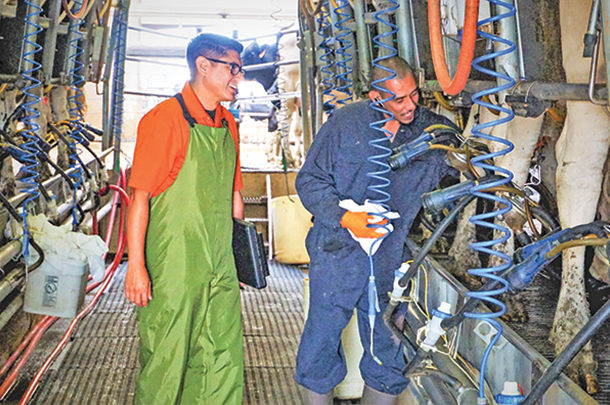The labor supply for agriculture has been changing in recent years. Some experts attribute this to stricter U.S. immigration policies and an improved economy in countries where much of the foreign-born agricultural labor originates.
The reality is: Even with tougher regulations on our borders, people still move to our country to fill jobs that are not desired by many of us. Thousands of jobs are filled by immigrants in cities and towns where domestic workers are reluctant to take manual labor jobs at payment levels below their expectations.
Instead of going to traditional agricultural jobs, the new wave of immigrants is opting for taking jobs where they can find a culture of inclusion, where they feel close to their roots, their beliefs and their drivers of motivation. Many are moving to communities where the external culture provides inclusion and support.
Generations after generations, agricultural businesses have tried to improve production efficiency while leaving aside a focus on human resources due to the large supply of labor. The times now are different, and we must change and invest in human resources to be profitable and adapt to this new reality.
Some think the solution will come from technology, replacing people with robots, even though the ag economy is unstable and access to technology is not for everybody. This way of thinking puts finding and retaining one of our most importance resources – people – under a great risk.
The labor force in U.S. agriculture depends heavily on individuals who are here for one reason and one reason only: to provide for their families. How can we attract people into our business and create a culture of higher worker retention? The answers are many, and they are not new. What we know is: It’s time to try to put greater consideration on the human side of our business.
One way to do that is to divide the human resources side of businesses into two main structures: physical and emotional. Following key processes in each area will create a work environment to help employers meet their goals and those of their workers.
Physical structure
The physical structure starts with the onboarding process and includes several components:
1. Create an employee handbook with a mission statement that creates a connection with the employee
Most employee handbooks don’t have the connecting link between the employee and the business. Instead, the mission statement is only based on profitability. We need to connect first in order to lead. Take the time to align your goals with their goals. Include statements like: “We milk cows to feed my family and you will feed your family too, by working together.”
2. Create clear rules, regulations and expectations
Take the time to do this regardless of the size of your operation and your role within the organization.
3. Training using the employee’s “why” in mind
When it comes to training, most industry recommendations are based on using the “why” behind mode of actions, processes and protocols. However, those recommendations often do not take into consideration the benefits for the employee and the connection with their “why,” wanting to provide for their families. Align protocols and procedures with that in mind, too.
4. Create the right training environment
Ask for goals and performance by showing respect. Providing a clean, organized and a fun environment will create a better educational outcome. If the training involves changes, these changes should not be sudden.
5. Review, give and receive feedback
Take the time to formally review your employees.
6. Re-train and feed the drive for curiosity
This is the time to find opportunities to increase performance by forming connections and defining expectations. We are always in the process of learning something new.
7. Establish benefits based on structured reviews
Be objective and clear when it comes to incentives and raises. Incentives must be based on performance and not only based on time or organization skills.
8. Know the culture of your operation by doing internal surveys
Don’t be afraid to ask questions that will help to build a stronger culture of retention for your organization; you will be surprised of the little things that can help you to build a better culture.
The use of personality tests as a resource may provide a platform of management opportunities by adapting or changing management styles based on employees’ personalities.
Emotional structure
The physical structure of a human resources program will not work if we don’t address the emotions employees bring to their work. Understanding what drives them is a fundamental part of job retention.
1. Use the drive to acquire
Every person wants to acquire something; every person has goals and wants to achieve something. Benefits are an important part of every organization, and they need to be tangible and intentional.
2. Use the drive to bond.
Make your employees feel part of your organization by explaining and sharing goals. Ask for feedback and invest time and resources on the feedback provided. Many changes in agricultural businesses are made without taking in consideration the employees. Have clear goals and celebrate achieved goals with your employees.
3. Use the drive to comprehend.
Employees are eager to learn. By providing continuous training we are reinforcing a culture of engagement, creating new opportunities for efficiency inside our organization.
4. Use the drive to defend.
Can you imagine if we can connect our employees to our business to the point that they will defend the business as their own? This can be achieved by forming connections with them and aligning our goals with their “why.”
Dairy owners and managers know the success of their businesses are based on investing resources in production, genetics, nutrition, facilities, records and more. However, often forgotten is that people are involved in every interaction, and that we depend on their abilities, skills and their drives of motivation to achieve successful outcomes.
Now is the time to change and invest in your workers. The solution will come from inside your businesses, creating internal and external cultures of retention, and not from political changes on immigration.







